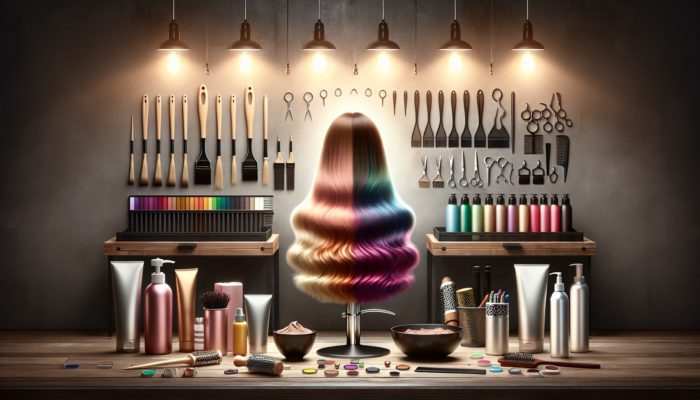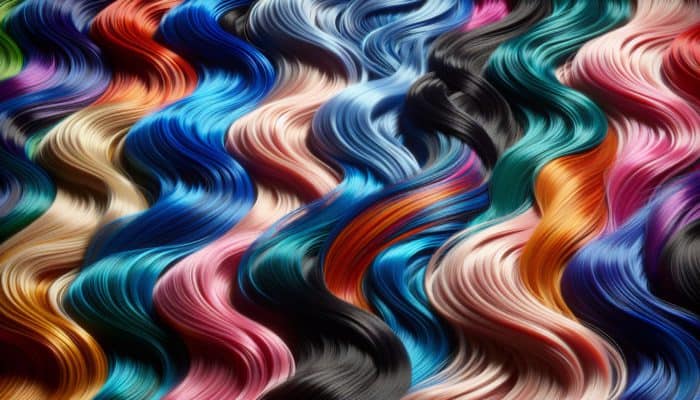Comprehensive Guide to Addressing Dull Hair Colour and Effective Solutions
What Are the Primary Factors Contributing to Hair Colour Loss?

The fading of hair colour can result from numerous factors, with intense sunlight ranking among the most prevalent. The UV rays emitted from the sun can degrade the artificial pigments present in dyed hair, resulting in a washed-out and lacklustre appearance. Besides sun exposure, chemical treatments like bleaching and perming strip hair of its natural oils, rendering it more vulnerable to fading. Additionally, environmental pollutants such as dust and smoke can accumulate on hair, diminishing its shine and vibrancy. Understanding these contributing elements is essential for effectively preventing and remedying dull hair colour.
Furthermore, the quality of water used for washing hair significantly influences colour retention. Hard water, characterised by high levels of minerals including calcium and magnesium, can lead to a build-up that detracts from the hair's texture and vibrancy. The regular use of harsh shampoos can exacerbate this issue by stripping away vital moisture and colour. Collectively, these factors can result in hair that appears lifeless and void of depth. By identifying these causes, individuals can more effectively tailor their hair care routines to combat fading and enhance overall vibrancy.
How Does Dull Hair Colour Affect Your Overall Appearance?
When hair loses its vibrancy, it often appears flat and lifeless, which can significantly detract from your overall appearance. Dull hair undermines personal style and can adversely impact self-confidence. A vibrant mane is often associated with health and vitality, while a lacklustre look may evoke feelings of unattractiveness. This emotional impact is particularly pronounced in cultures that place a premium on hair aesthetics, making it essential for individuals to maintain a vibrant appearance.
Moreover, dull hair might convey an impression of neglect or insufficient self-care. In various social settings—be they personal or professional—how one presents themselves can profoundly influence opportunities and relationships. Investing time and effort into preserving vibrant hair colour not only fosters personal satisfaction but also enhances social interactions and perceptions. Hence, prioritising vibrant hair as part of one’s self-presentation is crucial.
What Are the Clear Signs Indicating Dull Hair Colour?
Recognising the early indicators of dull hair colour is vital for implementing timely interventions. Common signs include a noticeable lack of shine, often the first signal that your hair requires attention. Furthermore, uneven colour distribution may indicate that specific areas have faded more than others, resulting in an unbalanced appearance. Lastly, a general lacklustre appearance devoid of dimension suggests that your hair needs revitalising care.
Being vigilant about these signs empowers individuals to take proactive measures. For instance, if your hair appears dull shortly after a colour treatment, it may be time to reassess your hair care routine—whether that involves incorporating colour-protecting products or scheduling professional treatments. Early detection plays a crucial role in maintaining the vibrancy of your hair colour.
Proven Strategies for Revitalising Dull Hair Colour

Inspiring Transformations: Success Stories of Hair Colour Restoration
The journey towards successful hair colour restoration is often exemplified through compelling before-and-after transformations. For example, a case study from a notable salon featured a client who transitioned from a dull, ashy blonde to a vibrant golden hue. This revival process involved a combination of a colour gloss and a deep conditioning treatment, resulting in a striking transformation that not only revitalised the hair but also significantly boosted the client’s confidence.
In another instance, the effectiveness of colour-refreshing shampoos was highlighted. A woman whose once-vibrant red hair had dulled over a few weeks successfully restored her hair's original vibrancy by integrating a colour-refreshing shampoo into her routine. These real-world examples illustrate the tangible results achievable with the right techniques and products, inspiring readers to consider their own hair transformations.
Essential Steps for Sustaining Vibrant Hair Colour
To maintain vibrant hair colour, consistent effort and the application of appropriate practices are crucial. To keep your locks looking lively, consider implementing the following actionable steps:
- Utilise colour-protecting shampoos and conditioners that shield your hair from fading.
- Incorporate regular deep conditioning treatments to nourish and hydrate your hair.
- Limit heat styling to prevent damage and fading.
- Rinse your hair with cool water to lock in moisture and enhance shine.
- Protect your hair from UV rays by wearing hats or applying UV protection sprays.
- Minimise exposure to chlorine and saltwater by rinsing your hair before swimming.
- Schedule regular touch-ups every 6-8 weeks for coloured hair.
- Ensure you stay hydrated and maintain a balanced diet to support overall hair health.
By integrating these steps into your hair care routine, you can significantly extend the longevity and vibrancy of your hair colour, laying a solid foundation for beautiful locks.
Expert Recommendations for Optimal Products to Revive Colour

Selecting the right products for colour revival can be a daunting task due to the multitude of options available. However, choosing products formulated with specific ingredients can greatly enhance the effectiveness of your hair care routine. For instance, opt for shampoos that are sulfate-free, as they are gentler on colour-treated hair. Brands like Olaplex provide treatments that repair damaged hair while preserving vibrancy.
Moreover, consider utilising colour-enhancing conditioners enriched with natural oils such as argan or coconut, which nourish and restore shine to your hair. Toners, especially those containing violet or blue pigments, effectively counter unwanted brassy tones in blonde and brunette hair, respectively. These products not only assist in maintaining colour but also offer additional benefits like moisture retention and texture improvement. By understanding product options, consumers can make informed decisions that cater to their specific hair needs.
How Does Your Lifestyle Affect the Longevity of Hair Colour?
Your lifestyle choices significantly influence the longevity of your hair colour. For instance, an unbalanced diet may lead to deficiencies in essential vitamins and minerals, directly impacting hair health. Nutrients such as biotin, vitamins A and E, and omega fatty acids are crucial for sustaining your hair's vibrancy. Including foods rich in these nutrients, like avocados, nuts, and leafy greens, can greatly enhance overall hair health.
Moreover, lifestyle factors like smoking can adversely affect hair colour longevity. The toxins found in cigarette smoke can cause oxidative stress, leading to premature colour fading. In addition, excessive sun exposure without proper protection can harm hair vitality. By adopting lifestyle modifications—such as wearing protective headgear during sun exposure or following a nutrient-rich diet—you can achieve more resilient and vibrant hair colour.
Professional Salon Treatments for Effective Colour Revival
Professional salon treatments provide an excellent option for those looking to effectively revive dull hair colour. Techniques like colour gloss treatments offer a quick solution for enhancing vibrancy. This treatment involves applying a semi-permanent dye that adds shine and boosts colour without the damage associated with traditional dyeing processes.
Another popular approach is the use of toners, which can adjust existing colour tones, eliminating brassiness and adding depth. Consulting with a professional stylist enables a tailored approach, ensuring that the selected treatment aligns with your hair type and desired results. Many salons also provide deep conditioning treatments that infuse moisture and nutrients back into the hair, revitalising its appearance and texture. By considering these professional options, individuals can achieve remarkable results that are challenging to replicate at home.
What Are the Most Effective Home Methods for Reviving Dull Hair Colour?
What Are the Most Effective DIY Techniques for Hair Colour Revival?
Reviving dull hair colour at home can be both rewarding and effective. DIY methods frequently utilise natural ingredients that restore vibrancy without the harsh chemicals found in many commercial products. For instance, a honey treatment can serve as a moisturising agent while imparting a natural shine. Simply mix honey with warm water and apply it to your hair, allowing it to sit for roughly 30 minutes before rinsing thoroughly.
Another effective method involves using vinegar rinses. Apple cider vinegar, in particular, can help clarify the hair by removing residues and enhancing shine. Diluting it with water and using it after shampooing can yield impressive results. Additionally, henna acts as a fantastic natural dye that not only adds colour but also strengthens the hair. By exploring these DIY methods, individuals can maintain the vibrancy of their hair colour while reaping the benefits of natural ingredients.
What Are the Advantages of Using Natural Ingredients for Hair Colour Revival?
Utilising natural ingredients for hair colour revival offers numerous benefits, particularly in terms of gentleness and nourishment. Ingredients like coconut oil are renowned for their ability to penetrate the hair shaft, delivering moisture and reducing breakage. Unlike chemical treatments that strip the hair of its natural oils, natural remedies enhance shine without inflicting damage.
Moreover, many natural ingredients are rich in antioxidants that combat environmental stressors, providing additional protection against colour fading. They are also less likely to trigger allergic reactions, making them suitable for a wide variety of hair types and sensitivities. Overall, incorporating natural methods into your hair care routine not only revives colour but also promotes healthier hair.
How Frequently Should You Treat Dull Hair Colour at Home?
The frequency of at-home treatments for dull hair colour largely depends on the severity of dullness and the specific treatment being employed. Generally, a good guideline is to perform treatments once a week. This routine allows for continuous nourishment without overwhelming the hair. However, for those with particularly dull hair, more frequent treatments, such as twice a week, may prove beneficial.
It is also important to diversify the types of treatments integrated into your regimen. For instance, one week you might opt for a honey treatment, while the next week, you could use a vinegar rinse or a deep conditioning mask. This variety not only keeps your routine engaging but also enables your hair to benefit from the diverse properties of various natural ingredients, ensuring comprehensive care.
Which Natural Ingredients Should You Avoid for Hair Colour Revival?
While many natural ingredients are beneficial, some should be avoided, particularly those that can strip hair colour or cause damage. For example, lemon juice is often praised for its lightening properties, yet its acidic nature can lead to hair drying out and losing its colour. Similarly, baking soda can strip away essential oils and moisture, resulting in dullness and brittleness.
It is essential to approach natural DIY methods with caution, recognising that not all ingredients are universally suitable. Staying informed about the potential effects of different substances can help prevent adverse reactions and ensure that your hair colour remains vibrant and healthy. Choosing more nourishing ingredients is key to achieving the desired results while avoiding the risks associated with potentially harmful alternatives.
What Professional Treatments Are Available for Dull Hair Colour?
Exploring Professional Techniques for Hair Colour Revival
Professional hair colour revival techniques encompass a variety of treatments designed to restore vibrancy and lustre. Colour gloss treatments are particularly sought after, as they provide a quick and effective way to enhance shine and depth without the long-term commitment of a full dye job. These treatments can add a layer of shine while nourishing the hair, making it look revitalised.
Another effective method is the application of toners, especially for those seeking to adjust or eliminate unwanted tones. For instance, a client with blonde hair dealing with brassiness can benefit from a purple toner that neutralises yellow undertones, resulting in a cooler, more polished look. Additionally, professional stylists often utilise colour refreshers, which can maintain and amplify the existing colour between full treatments, ensuring that hair remains vibrant and healthy.
How to Select the Right Professional Treatment for Your Hair?
Selecting the appropriate professional treatment involves a thorough assessment of your current hair condition, desired outcomes, and hair type. Consulting with a professional stylist is crucial, as they can analyse your hair’s state and recommend treatments tailored to your specific needs. For example, if your hair is fine and prone to damage, a colour gloss may be more suitable than a full dye job, which could weigh it down.
Factors such as existing colour, texture, and even lifestyle should guide your decision. Individuals with busy schedules might prefer treatments that require less maintenance, such as semi-permanent dyes or glosses, while those willing to commit to regular salon visits could opt for more permanent solutions. Ultimately, understanding your hair's unique needs will lead to more satisfying results and long-lasting vibrancy.
Why Are Regular Salon Visits Essential for Colour Maintenance?
Regular salon visits are crucial for maintaining vibrant hair colour. Professional stylists have the expertise to assess hair conditions and recommend appropriate treatments that not only rejuvenate colour but also improve overall hair health. These appointments facilitate timely touch-ups, which are fundamental in preventing dullness and fading.
Additionally, regular visits present opportunities for deep conditioning treatments that infuse vital moisture and nutrients back into your hair. Scheduling these appointments every 6-8 weeks can significantly aid in sustaining the vibrancy of your colour while ensuring that your hair remains in optimal condition. Investing in professional care is essential for anyone committed to keeping their hair colour fresh and lively.
What Strategies Can You Implement to Prevent Dull Hair Colour in the Future?
What Are the Best Practices for Preventing Hair Colour Dullness?
Preventing hair colour dullness is an ongoing commitment that necessitates adherence to several best practices. First and foremost, using colour-safe products is essential; opt for shampoos and conditioners specifically designed for colour-treated hair to preserve vibrancy. Additionally, minimising heat styling can prevent damage and fading, ultimately resulting in healthier hair.
Incorporating protective measures against environmental damage is also crucial. This includes applying UV protectant sprays when exposed to the sun and ensuring you rinse your hair after swimming to eliminate chlorine or saltwater. By integrating these practices into your routine, you can effectively safeguard against dullness and keep your hair looking fresh and vibrant.
Why Are Regular Trims Important for Colour Maintenance?
Regular trims represent an often-overlooked aspect of maintaining vibrant hair colour. Split ends and damaged hair can significantly detract from the overall appearance and vibrancy of your colour. Scheduling trims every 6-8 weeks helps eliminate these damaged ends, allowing your hair to appear healthier and more radiant.
Moreover, trims can enhance the shape and style of your hair, providing a more polished look. By prioritising regular maintenance, you not only improve the health of your hair but also create a strong foundation for colour vibrancy, ensuring that your investment in hair colour pays off over the long term.
How Can a Balanced Diet Influence Hair Colour Health?
A balanced diet plays an integral role in sustaining hair colour health. Nutrient-rich foods contribute to the overall vitality of your hair, promoting shine and preventing dullness. For example, incorporating proteins from sources such as fish, poultry, and legumes provides the necessary building blocks for strong hair.
Vitamins and minerals should also be a focal point; foods rich in biotin, vitamins A and C, and omega fatty acids nourish hair follicles. This internal support translates to healthier hair, which retains colour more effectively. By focusing on a diet that prioritises hair health, individuals can ensure that their hair remains vibrant and full of life.
How Often Should You Refresh Your Hair Colour to Prevent Dullness?
Refreshing your hair colour every 6-8 weeks is typically recommended to maintain vibrancy and prevent dullness. This frequency allows for timely touch-ups that keep the colour looking fresh while preventing significant fading. Regularly refreshing your colour combats environmental damage and the natural fading that occurs over time.
Furthermore, implementing a routine that includes professional colour treatments can enhance your hair’s appearance and prolong vibrancy. By being proactive and scheduling these refreshers, you can ensure your hair remains lively and beautiful, turning heads wherever you go.
FAQs
What causes hair colour to fade rapidly?
Hair colour fades quickly due to factors such as sun exposure, chemical treatments, and environmental pollutants that strip the hair of its vibrancy.
How can I identify if my hair is dull?
Indicators of dull hair include a lack of shine, uneven colour distribution, and an overall lacklustre appearance, which can be improved with targeted treatments.
What professional treatments are available for dull hair?
Professional treatments such as colour glosses, toners, and deep conditioning masks effectively revive dull hair colour and enhance shine.
How often should I apply DIY treatments for dull hair?
DIY treatments for dull hair can typically be applied once a week, although more frequent applications may be beneficial for severely dull hair.
Can my diet influence my hair colour?
Yes, a balanced diet rich in vitamins and minerals can significantly enhance hair colour health, promoting shine and preventing dullness.
What products are best for maintaining hair colour?
Colour-protecting shampoos, conditioners, and leave-in treatments are essential for maintaining vibrancy while preventing fading.
Is heat styling detrimental to coloured hair?
Excessive heat styling can cause damage and fading in coloured hair. It is advisable to use heat protectants and limit heat tool usage.
How can I protect my hair from sun fading?
Wearing hats or applying UV protectant sprays can effectively shield your hair from damaging UV rays that lead to colour fading.
Which natural ingredients should I avoid for hair colour revival?
Avoid using lemon juice and baking soda, as these can strip colour and dry out hair, leading to dullness.
How important are regular salon visits for hair colour maintenance?
Regular salon visits are crucial for maintaining vibrant hair colour, as professionals can provide timely touch-ups and treatments tailored to your needs.
Connect with us on Facebook!
The Article: Reviving Dull Hair Colour: Tips and Techniques appeared first on Amitys Hair Salon.
The Article Reviving Hair Colour: Tips and Techniques for Vibrancy Was Found On https://limitsofstrategy.com





No responses yet